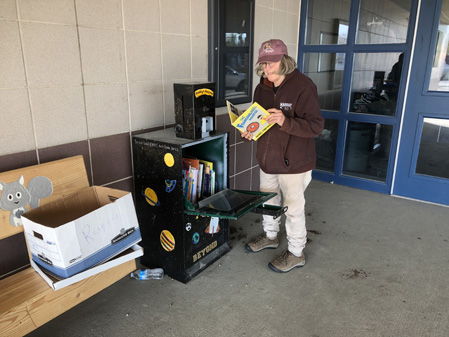
November 5, 2023: Cloudy with a Chance of Meatballs
I woke up this morning thinking of a book title, Cloudy with a Chance of Meatballs. The beautiful pen and ink drawings complement the story, which is about what happens when food falls from the sky, much like rain. All the foods kids like, meatballs and pancakes, practically engulf the town. Then, as I laid there, it occurred to me that many kids’ books fit into the category of magical realism. Defined, magical realism “paints a realistic view of the world while adding magical elements and in this way blurs the lines between fantasy and reality.” |
|
Magical realism is generally considered to be a different genre from fantasy because it includes realistic detail and magic elements to make a point about reality. Conversely, fantasy-based stories are often separated from reality or present an alternative universe. I noticed, not surprisingly, that the definitional references to magical realism apply to literature. And additionally, those most known for having penned books in this genre are the South American writers. These narrowly based classifications have been made by academics in literary circles. Magical realism came into its own in the late 1980s when I was a graduate student, working on my MFA degree at the University of Alaska, Fairbanks. Raymond Carver was accredited as being one of “the” writers to emulate. We never, ever talked about magical realism as the term relates to children’s books. I have in the past few years, come across and read hundreds of children’s books. And I have since come to realize that most fit into the above definition, as exclusionary as it might be. Others have made note of this. But this has not been the norm. Sure, just off the top of my head, The Cat in the Hat (Dr. Seuss), Mickey and the Night Kitchen (Maurice Sendak), Charlotte’s Web (E.B. White), and Frank and Ernest on the Road (Day) are excellent examples of books that should be given the magical realist fiction stamp of approval. Oh, and let’s add Alice and Wonderland to the list, although this book is considered to be for older readers. All these books, and many more, allow readers, young and old, to suspend disbelief. When reading, you believe that the Cat in the Hat appeared on a doorstep and invited himself into the lives of two initially disbelieving children. You are convinced that Mickey did float off one night and enter a baker’s kitchen. You have no problem envisioning Charlotte, Wilbur the Pig, and Templeton the rat conversing about Wilbur’s fate. And you have no doubt that Frank and Ernest, two redneck cows, will figure out how to get a semi-truck full of goods from Point A to Point B. The fact that these books and other books of their ilk are illustrated adds to their high degree of believability. You take in both the words and the illustrations and, at least momentarily, are transported elsewhere. The feeling is akin to what happens when you read the supposed “highbrow” literature My world view continues to expand. This would not be so if I hadn’t begun the BLBP. |
|
